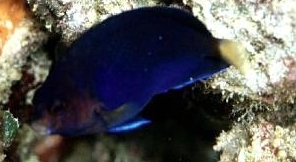
By Bob Goemans

Not Reef Tank Suitable
Likely Fish-Only Tank Suitable
Range: Indo-West Pacific Ocean: East Africa, and east to the Philippines, north to Southern Japan, and south to the Great Barrier Reef.
Size: 3 inches (7.5 cm)
Natural Environment: Inhabits macroalgae growths, sponge beds and areas where coral rubble collects on fringing reefs, reef channels, and seaward slopes at depths of 30 to 200 feet (10– 60 m). Feeds mainly on algae, worms, and crustaceans.
General Husbandry: This hardy dwarf angelfish is quite beautiful, as its body is generally a dark blue with bright blue edges on its median and pelvic fins with a pale yellow to white tail. Quite social with fish its size or larger, yet not smaller species. Its recommended this species be added to a well-established aquarium containing lots of live rock as it that will provide it many caves and crevices to explore and/or hide in when feeling threatened.
Diet should include Spirulina, marine algae, high-quality angelfish preparations containing sponge matter, fortified brine shrimp, mysis, and other meaty items. Two feedings per day is highly recommended, and its also recommended there be only one species from this dwarf angelfish genus in the aquarium, as they tend to develop aggression to other dwarf angelfish species.
This is one of the smallest Centropyge species and usually shows up in the trade somewhat shorter than what it attains in the wild. Therefore, as it will not usually get to its full length in captivity, it’s suited for small nano style aquariums. Yet if so, attention needs to be paid to its feeding needs, as without numerous feedings per day, be able to find enough food to be maintained long-term.
Taxonomy:
Order: Perciformes
Suborder: Percoidei
Family: Pomacanthidae
Genus: Centropyge
FYI: All Centropyge species start life as unsexed individuals, but begin their adult life as females. Then, the larger or more dominant individual within small groups will change sex within a few days to a couple of weeks and become a male. Knowing that size is the main difference between the sexes, and not so much its coloration, all one needs to do is place a small and larger specimen together. Within approximately sixty days one of the two fish will have physically changed sex to accommodate the other. A reversal of this sex change is possible if the need arises, but that requires much more time, e.g., weeks to months.
Keep in mind all angels have cheekspines at the edge of their gill cover; therefore use caution when handling and also avoid using a net to capture it, as it may become stuck or tangled in the net and become damaged when removed.
Experience Level: Intermediate
Temperament: Semi-aggressive
Diet: Omnivore
Acclimation Time: 30 minutes+
Aquarium Environment: Reef aquarium (see below) or fish-only aquarium
Reef Safe: No - Has a well-known natural tendency to nip large and small–polyped stony (LPS/SPS) corals.
Minimum Tank Size: 30 gallons
Temperature Range: 70 - 82°F (21 – 27°C).
Specific Gravity: 1.020-1.026
pH: 8.0 - 8.5
